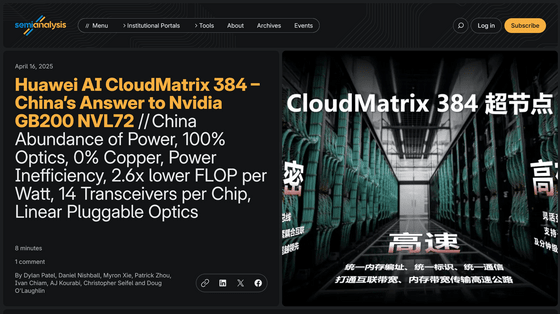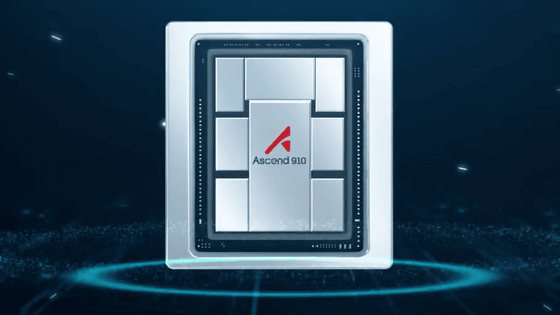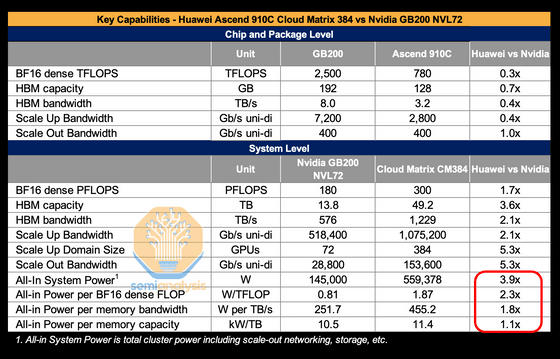Huawei releases new AI architecture 'CloudMatrix 384 Supernode' to rival NVIDIA, taking on 'NVL72' with 5x the chips and 4x the power consumption

by
As US sanctions limit Chinese companies' access to AI chips, Huawei has unveiled the CloudMatrix 384 Supernode , an AI infrastructure architecture that exceeds the computing power of NVIDIA's GB200 NVL72.
Tech war: Huawei launches new AI architecture said to rival Nvidia's products | South China Morning Post
https://www.scmp.com/tech/tech-war/article/3306644/tech-war-huawei-launches-new-ai-architecture-said-rival-nvidias-products
Huawei AI CloudMatrix 384 – China's Answer to Nvidia GB200 NVL72 – SemiAnalysis
https://semianalysis.com/2025/04/16/huawei-ai-cloudmatrix-384-chinas-answer-to-nvidia-gb200-nvl72/

Reportedly, Huawei's CloudMatrix 384 is equipped with 384 of the company's AI chips, Ascend 910C, and is positioned within Huawei as a 'nuclear-level product' comparable to NVIDIA's NVL72.
The NVL72, announced in 2024, will be equipped with 72 Blackwell GPUs interconnected by NVLink, a high-speed GPU-to-GPU communication technology, with a computing power of 180 PFLOPS (petaflops).
Meanwhile, the CloudMatrix 384 deployed at Huawei's data center in Wuhu, Anhui Province, China, is equipped with more than five times as many Ascend chips to compensate for the shortcoming of Blackwell's individual chip performance, which is only about one-third that of Blackwell, and has a total memory capacity of more than 3.6 times and memory bandwidth of 2.1 times. As a result, the CloudMatrix 384 achieved a performance of 300 PFLOPS, about 1.7 times that of the NVL72.

Huawei is reportedly planning to partner with SiliconFlow, a Chinese AI infrastructure startup, to support the Chinese-made DeepSeek-R1 inference model on the CloudMatrix 384.
'If the reports are true, they highlight how Huawei, a target of U.S. sanctions, is steadily moving toward achieving self-sufficiency in computing power amid rising technological tensions between the U.S. and China,' the South China Morning Post said.
The clear disadvantage of CloudMatrix 384 is that it is significantly less power efficient, consuming 3.9x the power of NVL72, 2.3x the power per FLOP, 1.8x the power per memory bandwidth, and 1.1x the power per memory capacity.

However, unlike Europe and the United States, where the increase in AI power consumption is a major issue , power efficiency is not a big issue in China, where carbon emissions from coal-fired power generation are not a concern. In addition, China is the world's leading nuclear power generation company, and is also the world's largest producer of solar, hydroelectric, and wind power, so the increase in electricity demand will not be a hindrance to Chinese companies, as pointed out by overseas media outlet SemiAnalysis.
However, the Ascend 910C that makes up the CloudMatrix 384 relies on Korean memory, Taiwanese wafers, and semiconductor manufacturing equipment from the United States, the Netherlands, and Japan, making it far from a Chinese-made chip. This high dependency on overseas hardware is a challenge for Huawei, and it is said that Samsung's help and TSMC's sanctions violation were essential to the production of the Ascend 910C.
TSMC may be fined more than 140 billion yen for using its chips in Huawei's AI processors - GIGAZINE

'TSMC is providing the Chinese company with 2.9 million semiconductor dies, enough to produce 800,000 Ascend 910B and 1.05 million Ascend 910C units between 2024 and 2025. If supplies necessary for semiconductor manufacturing, such as HBM , wafer manufacturing tools, and photoresists , are not effectively managed, SMIC's production capacity, which is responsible for manufacturing Ascend, could increase significantly,' SemiAnalysis said.
Related Posts:






